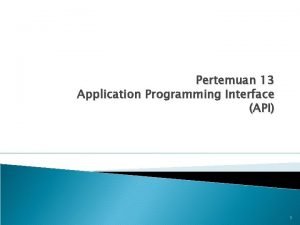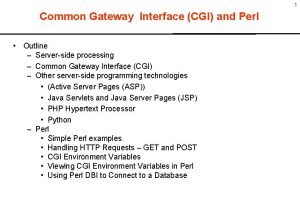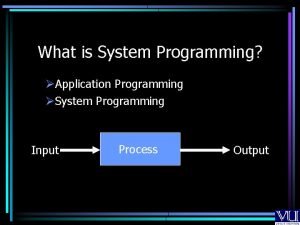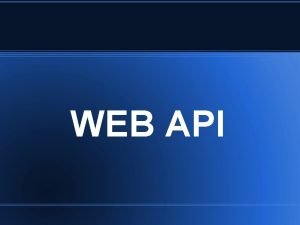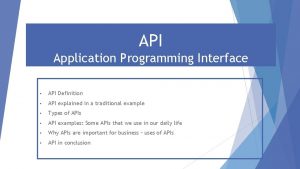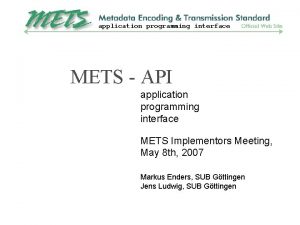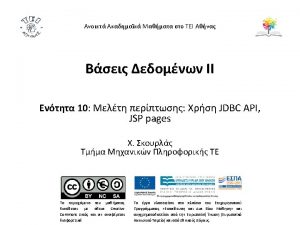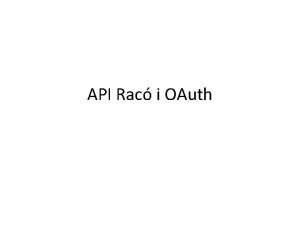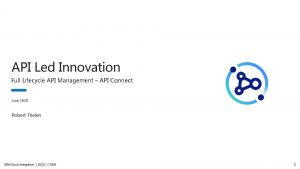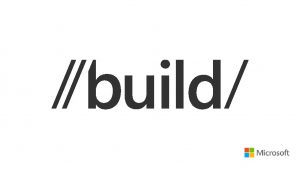Week 08 API Application Programming Interface What is






















- Slides: 22

Week 08 API (Application Programming Interface)

What is an API? • API: is a software-to-software interface, not a user interface. • With API, applications talk to each other without any user knowledge or intervention. • Note: Main goal of API is code/program reusable. • An API resembles Software as a Service (Saa. S), since software developers don’t have to start from scratch every time they write a program. • Instead of building one core application that tries to do everything, the same application can contract out certain responsibilities to remote software that does it better.

What is an API? Request App A App B Response Client Server

Types of API • Local API: is the original form of API which is the OS APIs that provide services to application programs (Front-end/GUI) requesting services or data from the back-end such as voice service or data from DB. • Program API: is based on RPC (Remote Procedure Call) technology that making a remote program execution from another servers. SOA (Service Oriented Architecture) APIs are sample of Program API. • Web API: also known as Web Service, is application/device communicate to each others via World Wide Web (HTTP architecture). • There are two kinds of Web Service: SOAP (Simple Object Access Protocol) and RESTful (REpresentational State Transfer)

What is SOAP Web Service? • SOAP Web Service: describes a standardized way of integrating Web-based applications using the XML, SOAP, WSDL and UDDI open standards over an Internet protocol backbone. • XML (EXtensible Markup Language) is used to tag the data. • SOAP (Simple Object Access Protocol) is used to transfer the data. (XML-based messaging protocol) • WSDL (Web Services Description Language) is used for describing the services available. (Written in XML) • UDDI (Universal Description, Discovery, and Integration) is used for listing what services are available (XML-based registry)

What is SOAP Web Service? • NOTE: Web services allow different web applications from different sources to communicate with each other without timeconsuming custom coding and because all communication is in XML. • Web services are not tied to any one operating system or programming language. For example, Java can talk with Perl, Windows applications can talk with UNIX applications.

SOAP Web Service SOAP App B App A SOAP Client XML Server

What is RESTful Web Service? • RESTful (REpresentational State Transfer) Web Service: also known as RESTful API, is based on REST technology which is an web application that uses HTTP requests to GET, PUT, POST and DELETE data. • REST technology is generally preferred to the more robust Simple Object Access Protocol (SOAP) technology because REST leverages less bandwidth, making it more suitable for internet usage. • With cloud use on the rise, APIs are emerging to expose web services. REST is a logical choice for building APIs that allow users to connect and interact with cloud services.

RESTful Web Service HTTP App B App A HTTP Client JSON Server

REST vs SOAP Web Services • REST Web Services: § RESTful web services are stateless. You can test this condition by restarting the server and checking if interactions survive. § For most servers, RESTful web services provide a good caching infrastructure over an HTTP GET method. This can improve the performance if the information the service returns is not altered frequently and is not dynamic. § Service producers and consumers must understand the context and content being passed along as there is no standard set of rules to describe the REST web services interface. § REST is useful for restricted-profile devices, such as mobile, for which the overhead of additional parameters are less (e. g. , headers). § REST services are easy to integrate with existing websites and are exposed with XML so the HTML pages can consume the same with ease. There is little need to refactor the existing site architecture. As such, developers are more productive because they don't need to rewrite everything from scratch; instead, they just need to add on the existing functionality. § A REST-based implementation is simple compared to SOAP. § REST does not enforce any message format such as XML or JSON. Whereas, SOAP is XML based messaging protocol.

REST vs SOAP Web Services • SOAP Web Services: § The Web Services Description Language (WSDL) describes a common set of rules to define the messages, bindings, operations and location of the service. WSDL is akin to a contract to define the interface that the service offers. § SOAP requires less plumbing code than REST services design (e. g. , transactions, security, coordination, addressing and trust). Most realworld applications are not simple and support complex operations, which require conversational state and contextual information to be maintained. With the SOAP approach, developers don't need to write plumbing code into the application layer. § SOAP web services, such as JAX-WS, are useful for asynchronous processing and invocation. § SOAP supports several protocols and technologies, including WSDL, XSDs and WS-Addressing.

API Economy • API economy (application programming interface economy): is a general term that describes the way application programming interfaces (APIs) can positively affect an organization's profitability. • An API is a customer interface for technology products that allows software components to communicate. • There was a time when only software professionals knew about APIs. Today, business leaders are aware of the financial impact APIs can have and companies are generating revenue by exposing APIs as business building blocks for third party applications. • The emerging financial effects of APIs on businesses have gained steam thanks in part to mobile and social media technologies. Major companies that have gained revenue from APIs include Sales. Force. com, Amazon, Facebook, Twitter, and Google.

Microsoft Azure – API Management • Microsoft Azure API Management (APIM): helps organizations publish APIs to external, partner, and internal developers to unlock the potential of their data and services. • API Management provides the core competencies to ensure a successful API program through developer engagement, business insights, analytics, security, and protection. • You can use Azure API Management to take any backend and launch a full-fledged API program based on it. • To use API Management, administrators create APIs. Each API consists of one or more operations, and each API can be added to one or more products. • To use an API, developers subscribe to a product that contains that API, and then they can call the API's operation, subject to any usage policies that may be in effect.

Microsoft Azure – API Management • API Management consists of the following components: • The API gateway is the endpoint that: § Accepts API calls and routes them to your backends. § Verifies API keys, JWT tokens, certificates, and other credentials. § Enforces usage quotas and rate limits. § Transforms your API on the fly without code modifications. § Caches backend responses where set up. § Logs call metadata for analytics purposes.

Microsoft Azure – API Management • The publisher portal is the administrative interface where you set up your API program. Use it to: § Define or import API schema. § Package APIs into products. § Set up policies like quotas or transformations on the APIs. § Get insights from analytics. § Manage users.

Microsoft Azure – API Management • The developer portal serves as the main web presence for developers, where they can: § Read API documentation. § Try out an API via the interactive console. § Create an account and subscribe to get API keys. § Access analytics on their own usage. • NOTE: For more information, see the Cloud-based API Management: Harnessing the Power of APIs PDF whitepaper. • https: //docs. microsoft. com/en-us/azure/apimanagement/api-management-key-concepts

Amazon AWS – Amazon API Gateway • Amazon API Gateway : is a fully managed service that makes it easy for developers to create, publish, maintain, monitor, and secure APIs at any scale. • With a few clicks in the AWS Management Console, you can create an API that acts as a “front door” for applications to access data, business logic, or functionality from your back-end services, such as workloads running on Amazon Elastic Compute Cloud (Amazon EC 2), code running on AWS Lambda, or any Web application. • Amazon API Gateway handles all the tasks involved in accepting and processing up to hundreds of thousands of concurrent API calls, including traffic management, authorization and access control, monitoring, and API version management. • Amazon API Gateway has no minimum fees or startup costs. You pay only for the API calls you receive and the amount of data transferred out.

Amazon AWS – Amazon API Gateway • Benefits: • Low-Cost and Efficient: § With Amazon API Gateway, you pay only for calls made to your APIs and data transfer out. There are no minimum fees or upfront commitments. • Performance at Any Scale: § With Amazon Cloud. Front integration, API Gateway allows you to take advantage of the worldwide network of edge locations to provide your end users with the lowest possible latency for API requests and responses. Amazon API Gateway also helps you manage traffic through throttling, so that back-end operations can withstand traffic spikes. Additionally, Amazon API Gateway helps you improve the performance of your APIs by caching the output of API calls to avoid calling your backend systems unnecessarily.

Amazon AWS – Amazon API Gateway • Easily Monitor API Activity: § After your API is deployed, Amazon API Gateway provides you with a dashboard to visually monitor calls to your services using Amazon Cloud. Watch, so you see performance metrics and information on API calls, data latency, and error rates. • Streamline API Development: § Amazon API Gateway lets you simultaneously run multiple versions of the same API, allowing you to quickly iterate, test, and release new versions.

Amazon AWS – Amazon API Gateway • Flexible Security Controls: § API Gateway provides you with tools to authorize access to your APIs and control service operation access. You can use AWS administration and security tools, such as AWS Identity and Access Management (IAM) and Amazon Cognito, to authorize access to your APIs. Amazon API Gateway can verify signed API calls on your behalf using the same technology AWS uses for its own APIs. If you already use OAuth tokens or other authorization mechanisms, Amazon API Gateway can use AWS Lambda to execute a custom authorizer to help you verify incoming requests. • Create RESTful Endpoints for Existing Services: § With Amazon API Gateway, you can create modern resource based APIs, and then use the dynamic and flexible data transformation capabilities to generate the requests in the language your target services expect. API Gateway also helps you protect your existing services by setting throttling rules to avoid overwhelming your backend infrastructure during unpredictable traffic spikes.

Amazon AWS – Amazon API Gateway • Run Your APIs Without Servers: § Amazon API Gateway tightly integrates with AWS Lambda to allow you to create completely server-less APIs. With Amazon API Gateway, you create REST APIs that your mobile and web applications can use to call publicly available AWS services through your code running in AWS Lambda runs your code on a high-availability compute infrastructure and performs all the heavy lifting and administration of your compute resources. • For more information, please refer to Amazon API Gateway Product Details. • https: //aws. amazon. com/api-gateway/details/

References • https: //www. youtube. com/watch? v=s 7 wmi. S 2 m. SXY • http: //searchmicroservices. techtarget. com/definition/appli cation-program-interface-API • http: //searchmicroservices. techtarget. com/tip/REST-vs. SOAP-Choosing-the-best-web-service • https: //www. tutorialspoint. com/webservices/what_are_w eb_services. htm • http: //searchmicroservices. techtarget. com/tip/REST-vs. SOAP-Choosing-the-best-web-service • https: //blog. aujas. com/2015/02/24/understanding-andtesting-web-services-part-1/ • https: //docs. microsoft. com/en-us/azure/apimanagement/api-management-key-concepts
 Contoh application programming interface
Contoh application programming interface Performance application programming interface
Performance application programming interface Windows 10 system programming, part 1
Windows 10 system programming, part 1 Week by week plans for documenting children's development
Week by week plans for documenting children's development What is interface in java
What is interface in java Fluidity in hci
Fluidity in hci Office interface vs industrial interface
Office interface vs industrial interface An interface
An interface Cfnc free application week
Cfnc free application week Cfnc free application week
Cfnc free application week Cfnc free application week
Cfnc free application week Cfnc college application
Cfnc college application Common gateway interface tutorial
Common gateway interface tutorial Interface between user and computer
Interface between user and computer User interface process application block
User interface process application block Perbedaan linear programming dan integer programming
Perbedaan linear programming dan integer programming Greedy vs dynamic programming
Greedy vs dynamic programming Linear vs integer programming
Linear vs integer programming Programing adalah
Programing adalah System application programming
System application programming Application of integer programming
Application of integer programming Text mining application programming
Text mining application programming Htcondor week
Htcondor week
